The Bay Area Content Marketing Meetup is a group of 500+ marketers. We’ve met monthly for the past 3+ years.
Recently, we hosted an AMA (Ask Me Anything) with a panel of marketing experts.
Great panel discussion on content marketing last night at @Content_Meetup.@Greencognito moderated; panelists were Vincent Morello, @KMoutsos and @totheweb.
FYI: @MoninaW #BayArea #contentmarketing pic.twitter.com/uCU3jsFojB
— Dennis Shiao ✍️ (@dshiao) April 18, 2019
The panel
Rich Schwerin, Senior Content Strategist at Autodesk, moderated the panel. The panelists:
Rosemary Brisco, CEO, ToTheWeb
Vincent Morello, Senior Director, Head of Content at Snowflake Computing
Kim Moutsos, VP Editorial, Content Marketing Institute (CMI)
In this post, I’ll summarize some of the interesting things I heard from the panel.
Definition of content marketing
To set a baseline for the evening’s discussion, Rich asked the panel to define “content marketing.”
Kim shared CMI’s definition of content marketing:
“Content marketing is a strategic marketing approach focused on creating and distributing valuable, relevant, and consistent content to attract and retain a clearly defined audience — and, ultimately, to drive profitable customer action.”
Focusing on the word “profitable,” Rich expanded on what “profitable customer action” means. “Profitability is good, but it’s not mandatory. Content marketing ought to be mutually beneficial to the publisher and its audience,” says Rich.
I chimed in to share my favorite definition of content marketing, which comes from Jay Acunzo:
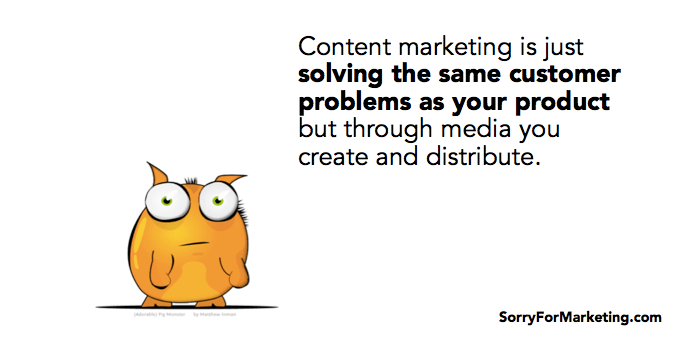
Image source: Jay Acunzo.
“Content marketing is just solving the same customer problems as your product but through media you create and distribute.”
Create tools that are useful to your target audience
Rosemary runs ToTheWeb, a B2B demand generation agency.
With so many blog posts being published today, it’s hard to get noticed. Rosemary has found success building tools for her clients’ target audience. Rosemary has a great example on her own website: a set of free tools for search marketers:
Rosemary called this the sweet spot for her customers, since they provide useful tools their audience loves. The tools help strengthen brand loyalty with existing customers and are great for driving traffic and generating sales prospects.
The tools will drive inbound links to your website (e.g., from articles or posts that link to your tool). In addition, Rosemary says, “The presence of these tools lifts traffic to other pages on your site. Once users experience the tool, they’ll go deeper and visit related pages.”
For more tips and to understand just how much tools have helped Rosemary’s own site, read her blog post “The Power of Online Tools to Drive Targeted Traffic Year-Over-Year.”
HubSpot has a great tool example — Website Grader. They’ll review your website and generate a report card, highlighting areas you’re doing well and areas you can improve in.
Users provide their email address and website URL to run the report, so it’s a neat way for HubSpot to generate leads for their marketing software.
Note: as a marketer, you conceive the idea behind the tool; however, unless you have coding skills, you’ll need to leverage or hire web developers to build the tool.
Related post: Level Up Your Content Marketing Game.
There’s more to Martech than “tech”
There’s never been so much technology available to marketers. Scott Brinker’s latest marketing technology landscape lists “6,829 marketing technology solutions from 6,242 unique marketing technology vendors.”
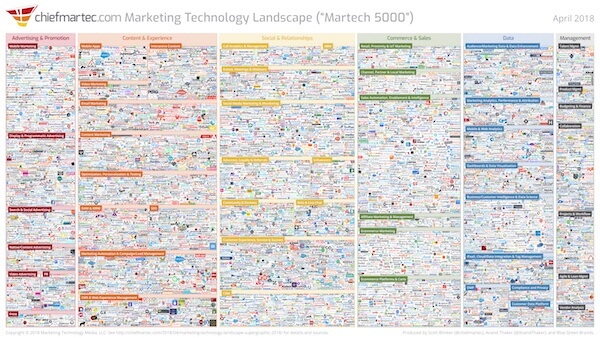
Image source: chiefmartec.com.
While technology is useful and has great potential, Kim says that people and process factors are just as important. “Technology is great, but success can depend on how well it’s set up and how willing people are to use it,” says Kim.
For example, a company could bring in a great reporting automation tool, but apathy, inertia or insufficient training could cause users to stick with their manual spreadsheets. In addition, two groups could have completely different opinions of the same tool.
For example, Engineering might love the new project management tool, while Product Management hates it. The former is in there all day, while the latter sits on the sidelines. The tool isn’t used to its full capacity, leading management to call it a failure.
When bringing in new technology, Kim urges marketers to consider existing workflows. “Do you have to change your workflow to adopt a tool? Instead, look for tools that adapt to your workflows,” says Kim.
Related research: content technology
A few days after the panel, Content Marketing Institute its third annual Content Management and Strategy Survey.
In a post about the research, CMI’s Robert Rose writes, “Only 16% of the respondents say they have the right technology AND are using its full potential.” Here’s the chart:
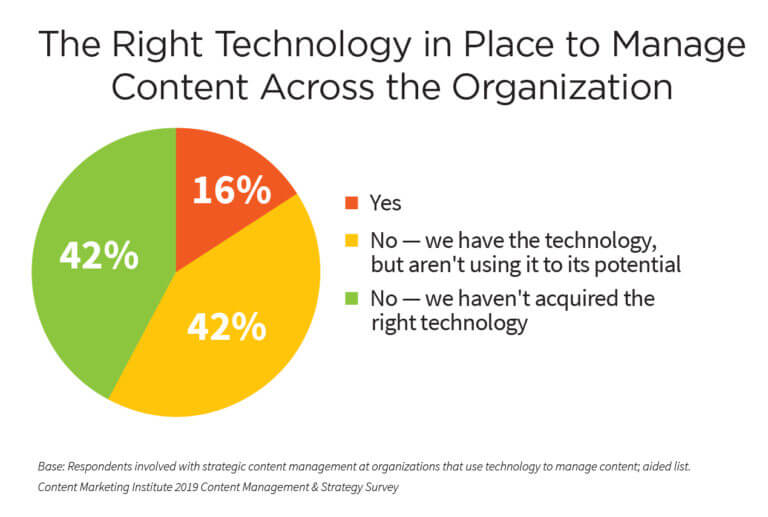
Image source: Content Marketing Institute.
It’s interesting that 42% haven’t acquired the right technology, while another 42% have the technology, but aren’t using it to its full potential.
Measuring the success of content marketing
Page views, bounce rate, time on site? How does one measure the success of content marketing?
Rosemary looks at this framework:
- Attract
- Convert
- Retain
She then reviews reports and metrics in Google Analytics to determine how well the content on a site is attracting an audience, converting them (e.g., as measured by defined actions or goals) and holding them.
“It all comes down to business goals,” something that Kim stated throughout the evening. To measure success, identify and document your business goals, then map those goals to metrics and reports in your analytics system.
Kim and Rich discussed the concept of “B.S. metrics,” things that some marketers like to brag about, but are ultimately trivial.
Kim defined B.S. metrics as “those you don’t use to take action.” Rich added that useful metrics provide insights that lead to action.
For example, it’s great that your blog post got 100,00 page views or 20,000 social shares; rather than celebrate the numbers, however, ask what the numbers tell you and what you’re going to do in response.
Maybe the post was on a different topic and you opened yourself up to a brand new audience. Or, a notable influencer tweeted your post, which then got retweeted by her audience. Possible actions here? To create more content on the new topic and to develop a closer relationship with the influencer.
For Vincent, content is produced to serve the needs of the business. So his measure of success for his team’s content efforts are how effectively it drives revenue. At Snowflake, the majority of revenue can be attributed to marketing programs and the content running in various campaigns.
Related post: Connect Your B2B Content Marketing to Business Results.
The customer journey is dynamic
The customer journey is different for each customer; as marketers, while we have to map, measure, and modify the journey, ultimately we have little control over it. According to Rich, the journey is winding, going on and off property like Chutes and Ladders:
Here’s panel moderator @Greencognito at @Content_Meetup tonight, opining on multi-touch attribution, the customer journey and more. pic.twitter.com/vChZoyZDT3
— Dennis Shiao ✍️ (@dshiao) April 18, 2019
Vincent noted that the customer journey can include actions you’d never expect. He shared the case of one enterprise deal where a decision maker downloaded a top-of-funnel asset (e.g., a “Dummies” guide) as the last touch before the deal closed.
While this was probably a random occurrence (e.g., perhaps the user downloaded it to pass along to a friend), a simplified last-touch attribution model may have awarded this asset too much credit.
The panel noted that customers can share anecdotes with salespeople that don’t get captured in marketing automation systems. In on example, a customer saw a vendor’s magazine ad and mentioned that to the salesperson. The advertisement probably should receive some credit in the closed deal, but attribution reporting would have given it zero.
Useful content marketing resources
The panel covered a wide range of content marketing topics. We put together a Google Doc that lists the questions covered. The document also lists resources from Content Marketing Institute that address each question:
Here were the questions the panel addressed. As a useful takeaway, @KMoutsos was kind enough to pair each discussion topic with articles from @CMIContent.
There's also a bonus post by @crestodina on Google Analytics.
Check it out: https://t.co/U9IiZFSx7l #contentmarketing pic.twitter.com/QgwxXzNxGi
— Dennis Shiao ✍️ (@dshiao) April 18, 2019
Your turn
What questions do you have about content marketing? Feel free to leave them in the comments area below. Thank you!
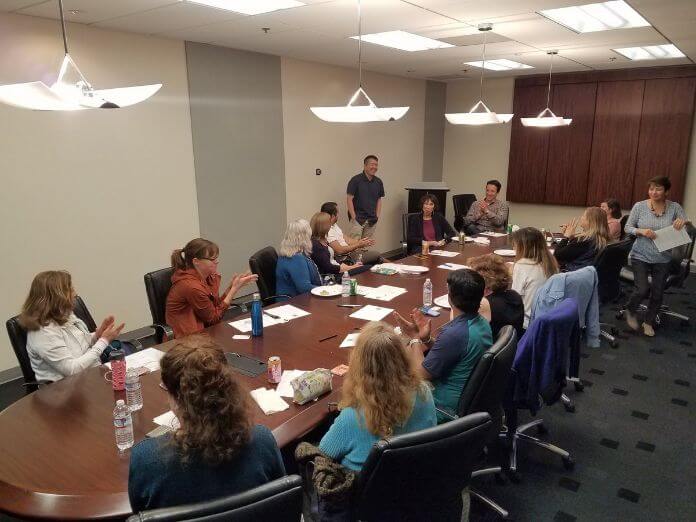
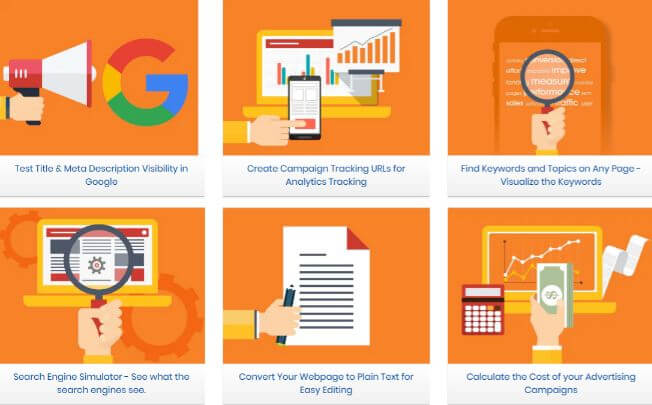
0 Comments on "Content Marketing Experts on Measuring Success, The Customer Journey and More"